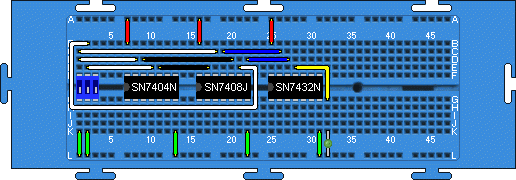Clk - Clock Chip (Set to 100kHz)
SN7404 - Hex Inverters
SN7410 - Triple 3-Input Positive Nand Gates
SN7400 - Quadruple 2-Input Positive Nand Gates
Here the 7404 Inverter is used to make the switch appear to be LOW
in off state and HIGH in on state instead of NC and LOW respectively.
If connected to the other power rail the switch would effectively
be always HIGH as the chips float HIGH with no connection.
This circuit shows that larger, more useful circuits can be created
and simulated using the Java BreadBoard Simulator.

Clk - Clock Chip (Set to 1MHz)
SN7474 - Dual D-Type Positive Edge Triggered Flip-Flops with Preset
and Clear.
Advancing the simulation by 1 microsecond steps will see the LEDs
count 4-bit binary with the most significant bit on the left. Using
the step function will also show that due to the propagation delays
that when two led are supposed to light together there is actually
a delay between them.
The two dip packages provide preset and clear for the two pairs
of bits.





